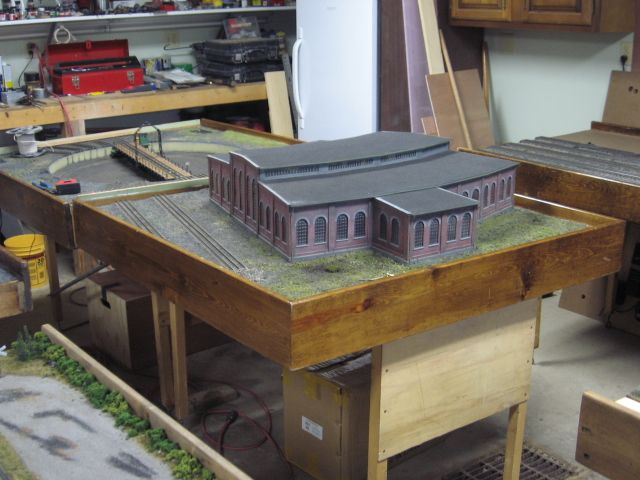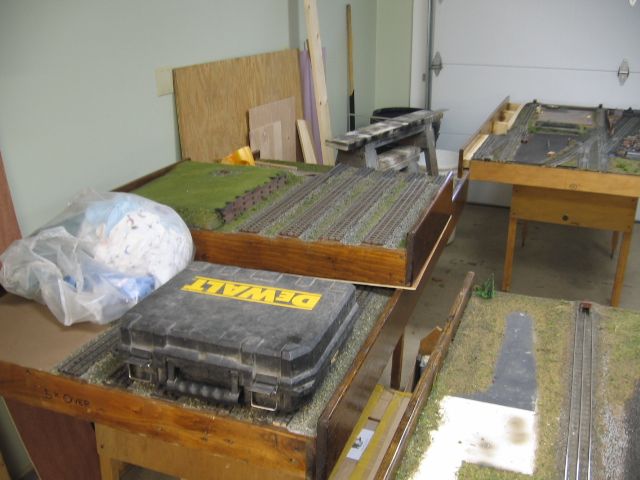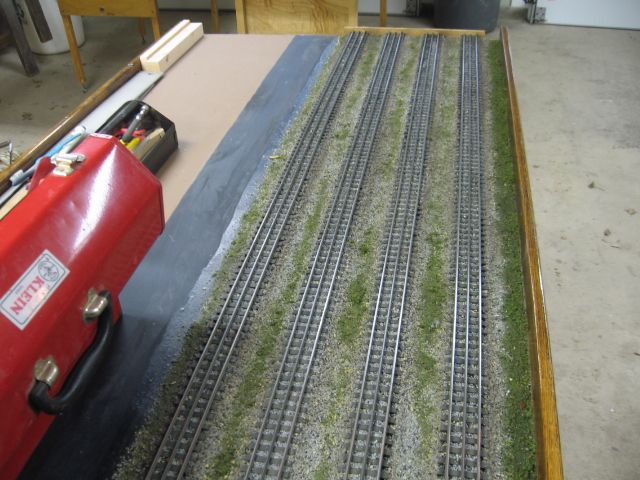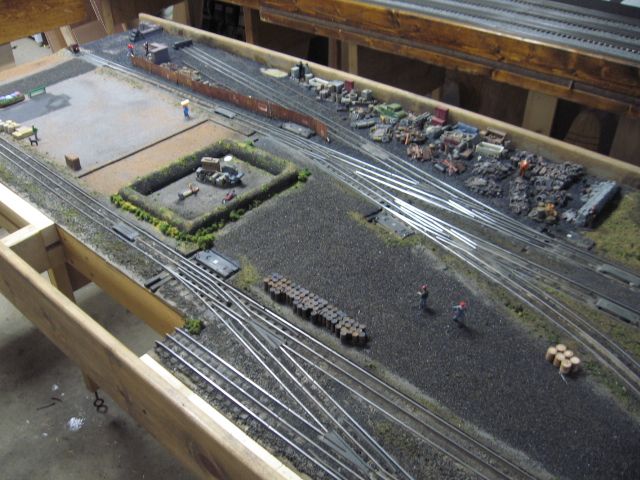Can someone please tell me the mix for glueing down ballast? % of water to % of glue.
Thanks,
David
|




|
Can someone please tell me the mix for glueing down ballast? % of water to % of glue.
Thanks,
David
Replies sorted oldest to newest
Not really critical. I use 50/50, assuming we are talking about white glue. More important is to spray wet-water (water with a few drops of dish detergent) onto the work first in order to break surface-tension.
Thank you for your answer. That is what I was looking for.
David
I use the same formula for the white glue. I never have sprayed the mix like Pete said. I just take the bottle of white glue empty half the glue out add water with dawn mixed in. Shake the bottle to mix then squeeze the bottle dribbling it out on the ballast.......Paul
actually the most important thing to do is pre-wet the ballast with water and isopropyl alcohol... then use the 50-50 mix.
actually the most important thing to do is pre-wet the ballast with water and isopropyl alcohol... then use the 50-50 mix.
Yes, alcohol can also be used as a wetting agent. Will do the same thing as wet-water. The latter is cheaper, though.
David,
A 50/50 mix works well. I put a squirt of dish detergent in the mixture to break up the surface tension. A baby bottle works well to apply the mixture as it is very controlled and accurate. That leaves very little mess to clean up and speeds the process along.
Ed Kazarian
David,
A 50/50 mix works well. I put a squirt of dish detergent in the mixture to break up the surface tension. A baby bottle works well to apply the mixture as it is very controlled and accurate. That leaves very little mess to clean up and speeds the process along.
Ed Kazarian
I must have done miles of ballast, Ed and I never thought of a baby bottle.
Brilliant! ![]()
The best part is that you can bin the teat if it clogs up.
Cheers
Can someone please tell me the mix for glueing down ballast? % of water to % of glue.
Thanks,
David
Do NOT NOT NOT glue down your ballast! When you want to change or attempt to repair or add wires it is a GIANT hassle! I learned the hard way. NEVER again.
Loose ballast is not a good idea for several reasons. And,as long as you use white glue and water as a bonding agent, you can easily remove ballast by simply re-wetting with water. No muss, no fuss.
Also, it's not necessary to go to 50:50 80% water is strong enough to hold the ballast in place and easily washed away later.
If you find that your mix isn't holding well enough, just go over it again. The water evaporates, so the glue gets stronger with each application.
Cheers
Loose ballast WILL find its way into the gearing sooner or later. I had a single grain of small ballast stop my Atlas GP9 dead in its tracks.
I don't like ballast at all, but it's a necessary evil if you want your RR to look the part.
I've been trying to find rubber or cork ballast that's been ground up and set it in place using Matte Medium to help quiet things down.
My plans are to ballast outside the rails and leave between the rails unballasted.
It's EZ to remove glued ballast with water, the hard part is to replace damaged gears/trucks on engines.
I read a lot of the pros and cons of using glue with the ballast. I was a little concerned with the gears. Mostly I used glue because I like to have kids "view" the layout and their fingers tend to gravitate to places that cause trouble. I will probably regret this the first time I have to replace a switch or something like that
Ed
And (I have tried on a single section of mainline, for testing) to assist with sound reduction, make use of the ballast to secure you track. Forego the use of screws
to secure your track sections. If placed properly, the ballast may be sufficient to
hold trackage in place. A minimum use of screws on curves should be sufficient on most layouts, none on straight sections, just using ballast to hold. Also, a bit more "prototypical" ?
Just a thought to try out and see whether it may suffice for your own purpose.
Jesse
I just finished ballasting about 10 feet of mainline today. The hardest part...was getting off my butt and doing it!
I cleaned off the areas I was going to do, sprayed a 50-50 mix of water-isopropyl alcohol along both sides of the track, then used a 3oz measuring cup to pour the ballast down the sides (not putting it in between the rails), followed by a swipe of a brush to tidy it up.
I repeated the spraying of the alcohol/water mix to hold the ballast in place, then I coated the ballast with a 50-50 mix of Matte Medium-Water, poured from a squeeze bottle.
It'll probably take 2 days to dry and I ran out of ballast so I need to get to the LHS to get more.
It's not as bad as I remembered, just need to make sure everything I don't want to get glue on is out of the way cause it's going to get messy anyway.
I too use the 50/50 water and white glue formula. One thing that helps me is to use automotive brake cleaner to pre wet the ballast. Once the glue is down I wipe the rails and I'm done.
For portable modules, 50/50 water and white glue is a must. A few drops of detergent are sufficient. Following a suggestion I read in O Guage Magazine years ago, I start applying the mixture between the rails until it bleeds to the outside. Then soak from the top of the ties until the mixture bleeds to the outside edge of the ballast. Having already gluing the adjoining landscape, the ballast glue bleeds into this as well, making a durable finish that lasts and survives the obvious abuse that modules must endure.
In reality there's no absolute right or wrong way - whatever works for you is the right way! Being both frugal and preferring to work smart rather than hard, i have found 20% - 30% white glue with a drop of dish detergent is sufficient to hold the ballast in place. I just give it a soaking spray, smooth it out with a stiff bristle narrow paint brush (and sometimes my finger), and wipe the tops of the rails with a paper towel. Done!! It's stayed in place for over 20 years.
I use chicken grit for balast.I have noticed that you may have to go over it a second time to get it to glue down good.Nick
John C. posted:Do NOT NOT NOT glue down your ballast! When you want to change or attempt to repair or add wires it is a GIANT hassle! I learned the hard way. NEVER again.
There is another reason that ballast NEEDS to be glued down. If you don't, you can never clean your layout with a vacuum without losing all your ballast.
Equal parts of water and white glue with a little dish detergent mixed in to decrease the surface tension.
Spray the ballast with water mixed with a little dish detergent prior to applying the glue.
The spurs have proportionally more cinders added in.
Peter
I would add that mechanically working the glue/ballast mixture, once applied, helps eliminate the glue bridge-ing that the wet water helps eliminate. Thicker the ballast, the more likely glue bridge-ing will occur.
Note these modules. I like to add some green.




I'm from the "there's no absolute right way to do it" school. For what it's worth and I'm not an expert but, Peter Riddle, who some might consider one, only glues the ballast on the outsides of the rails using the 50/50 mixture, wet water technique.
Just sayin'.
Mike
Access to this requires an OGR Forum Supporting Membership
